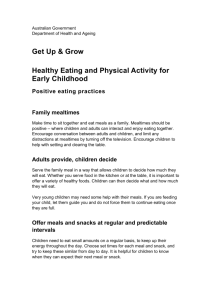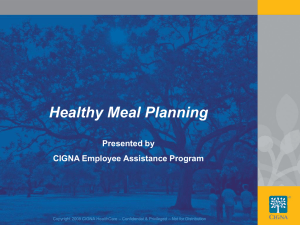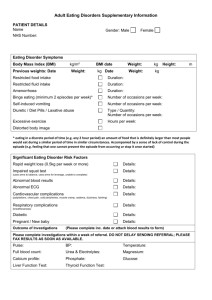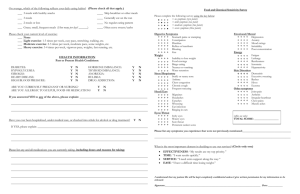7 questions - Ryan Raffa
advertisement
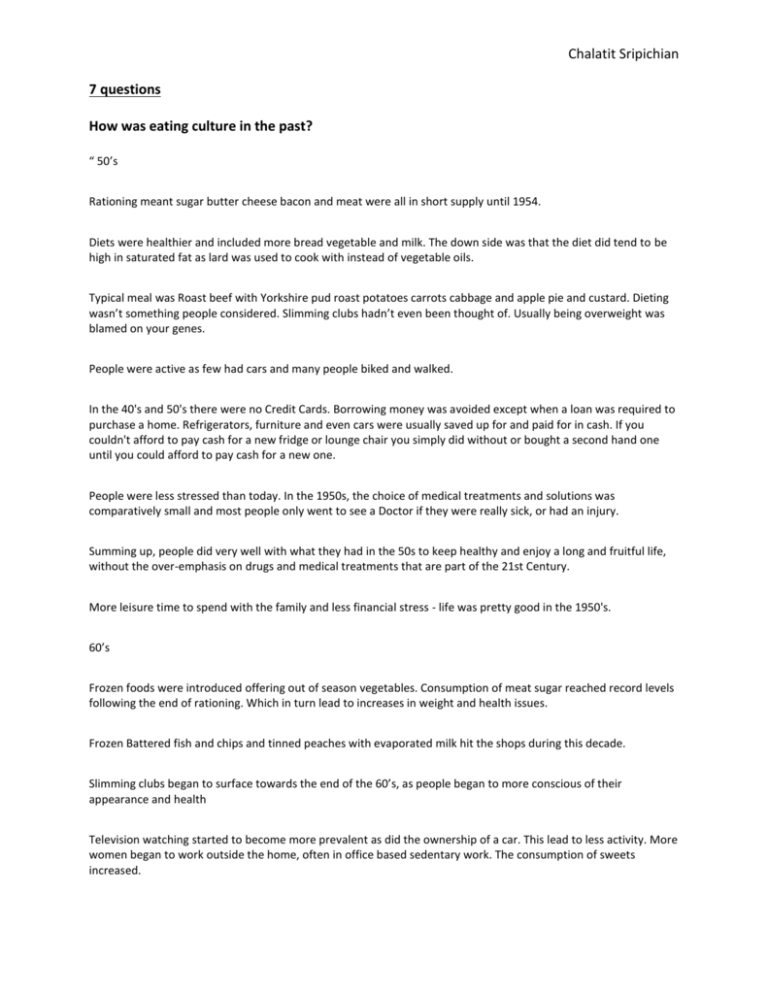
Chalatit Sripichian 7 questions How was eating culture in the past? “ 50’s Rationing meant sugar butter cheese bacon and meat were all in short supply until 1954. Diets were healthier and included more bread vegetable and milk. The down side was that the diet did tend to be high in saturated fat as lard was used to cook with instead of vegetable oils. Typical meal was Roast beef with Yorkshire pud roast potatoes carrots cabbage and apple pie and custard. Dieting wasn’t something people considered. Slimming clubs hadn’t even been thought of. Usually being overweight was blamed on your genes. People were active as few had cars and many people biked and walked. In the 40's and 50's there were no Credit Cards. Borrowing money was avoided except when a loan was required to purchase a home. Refrigerators, furniture and even cars were usually saved up for and paid for in cash. If you couldn't afford to pay cash for a new fridge or lounge chair you simply did without or bought a second hand one until you could afford to pay cash for a new one. People were less stressed than today. In the 1950s, the choice of medical treatments and solutions was comparatively small and most people only went to see a Doctor if they were really sick, or had an injury. Summing up, people did very well with what they had in the 50s to keep healthy and enjoy a long and fruitful life, without the over-emphasis on drugs and medical treatments that are part of the 21st Century. More leisure time to spend with the family and less financial stress - life was pretty good in the 1950's. 60’s Frozen foods were introduced offering out of season vegetables. Consumption of meat sugar reached record levels following the end of rationing. Which in turn lead to increases in weight and health issues. Frozen Battered fish and chips and tinned peaches with evaporated milk hit the shops during this decade. Slimming clubs began to surface towards the end of the 60’s, as people began to more conscious of their appearance and health Television watching started to become more prevalent as did the ownership of a car. This lead to less activity. More women began to work outside the home, often in office based sedentary work. The consumption of sweets increased. Chalatit Sripichian 70’s Vegetable consumption begins to fall while red meal consumption was almost twice as much as it today. Continental foods arrive including pizza pasta olive oil French bread and American ice cream. Most popular foods were prawn cocktail steak and chips and black forest gateaux. The domestic appliance market increased dramatically and 64% of homes had a washing machine. In1974 the first domestic microwave cooker was sold and microwave meals began to be sold in supermarkets. By 1978 television watching had increased hugely with millions of people now owning a TV and people could now watch television programmes in colour. Three stations had began broadcasting in colour between 1967 and 1969. By 1971 91% of families had a TV. Also VHS video recorder went on sale meaning no missing your favourite programmes. Dieting including ideas such as eating very little bread and potatoes, which were said to be fattening, not realising it was what went with them. Calorie counting was also the way to do it. Slimming clubs were on the increase with lots of organisations starting up. Slimming pills were also introduced onto the market place and often prescribed by doctors. Car ownership again increased and people moved less and ate more. 80’s This was really a decade of huge change with food production and consumption. The was a growth era of convince foods and ready meals. People brought and relied on ‘Ping’ meals and the microwave boom. Takeaway sandwiches also took off in a big way, with sandwich bars opening and the ready-made supermarket sandwich. Typical meal might be Chicken liver pate, lasagne and salad and lemon cheese cake As the computer era booms so do our waistlines as less and less employment involves activity. Also more and more households have TV and videos and labour saving devices, washing machines tumble dryers Hoovers are all commonplace Car ownership reaches almost 1 car per household, less and less activity Dieting ideas changing from calories to high fibre diets – Remember the F Plan? Also meal replacement such as Cambridge diet and slim fast are introduced, as were slimming appetite suppressants. Bran slim, Aids? By 1982 Over 50% of households now had a telephone. In 1988 digital mobile phones invented (they were expensive and large). 90’s This decade saw the rise of the junk food combined with more sedentary lifestyles And during this decade we see a marked increase in obesity as the obesity epidemic explodes. Massive growth in Italian and Indian ready meals with contain large amounts of fat and salt and calories. Typical meal was Vegetable samosa, chicken tikka massla tiramisu. However there was an increase in emphasis on low fat diets and healthy eating. Although many refusing to change eating habits and also continuing to buy processed foods and takeways.” Chalatit Sripichian http://www.weightoffworkshops.com/index.php/story/changing_tastes_and_lifestyle_over_the _past_60_years_diamon_jubilee/ How is eating culture nowadays? “More families are choosing to eat out at pubs and ‘fast casual’ restaurant chains like Nando’s, according to new research seen exclusively by Marketing Week.” http://www.marketingweek.co.uk/sectors/food-and-drink/trends/eating-out-is-the-newstaying-in/4008835.article Why do people choose to eat out rather than eat at home? - Can't cook, won't cook “ Eating out gives those in charge of meals at home, a break from the monotony of chopping, preparing, cooking, serving and quite possibly clearing up afterwards. Eating out allows them the luxury of being waited on while others do all the hard work. Sometimes it may re-ignite a passion for cooking, providing inspiration to try new dishes at home.” http://www.lifepaths360.com/index.php/reasons-why-people-choose-to-eat-out-2-3503/ Why don’t people cook anymore? – It has something to do with time. “First of all, these days a lot of people are really pressed for time, and dining out at a fast food type restaurant can save a lot of time. You get the food very quickly, and it doesn't take that long to eat it. You don't have to spend time shopping, coming up with an idea of what to eat, or cooking the food. Dining in sit down restaurants takes a bit more time, but it is still less time consuming than making the meal yourself.” http://bikal-bhmnotes.blogspot.com/2011/01/why-do-people-dine-out.html Is eating out bad for health? – Yes, in some ways. “Although restaurants are offering more nutritious food options these days, the choices are often limited. Most foods that are served in restaurants contain high amounts of fat and calories, and they can be detrimental to your health if they are consumed on a regular basis.” http://www.fitday.com/fitness-articles/nutrition/healthy-eating/6-reasons-why-you-shouldstop-dining-out.html#b Do eating out have other disadvantages except for bad for health? - Yes “As with anything there are 2 sides to the coin for every benefit there is a disadvantage starting with the cost. As we enter the fifth year of a very challenging economic climate we are watching our pennies very carefully. Eating in restaurants although a favourite pass time comes at a cost and with retailers offering deals to dine in for £10 there is an argument to say we are better off Chalatit Sripichian eating at home. This leads us on to the convenience of eating at home and not spending time traveling or making the effort to visit restaurants. With celebrity chefs on TVs showing us how to whip up fantastic, cost effective meals in less than 30 minutes eating at home is becoming more attractive. Finally although service levels have greatly improved I am sure we all don’t have to think too long back to remember a poor experience we have had in a restaurant. Even in our favourite restaurants we can be frustrated with the quality or service so why not save your money and take matters into your hands. At least cooking at home gives you the power to serve the food when you want and pour another glass of wine when you want whilst at the same time saves money and disappointment.” http://www.xpressrecruitment.com/Benefits-and-Disadvantages-of-eating-in-Restaurants108.html Are there benefits of eating out? - Yes “ With our daily lives getting busier as the years role on, convenience and time saving measures are more and more important to us. Having someone cook for you and serve you allows us not to have to worry about going to the supermarket or spending time preparing meals. Eating out allows us to continue with our hectic schedules whilst still satisfying our culinary appetites. We all enjoy trying something new and embracing different cultures and traditions. Restaurants in towns and cities across the UK are specialising in all types and styles of menus allowing us to sample exotic cuisines from across the globe. A key benefit of eating in Restaurants is that it provides the opportunity to try something that normally we wouldn’t cook or serve ourselves. As paying guests we all have certain expectations regarding quality and service within restaurants. Although generally service and quality over the decades has improved considerably if we are not satisfied we have the right to complain and demand improvements. This key benefit should result in a consistent standard and value for your hard earned cash. Finally everyone enjoys the sense of occasion and atmosphere of eating out whether it be a family occasion dinning out for Sunday lunch or a romantic candle lit dinner for 2. Making the effort to dine out is and always will be one of our favourite pass times and a way to mark an anniversary, birthday or celebration.” http://www.xpressrecruitment.com/Benefits-and-Disadvantages-of-eating-in-Restaurants108.html



